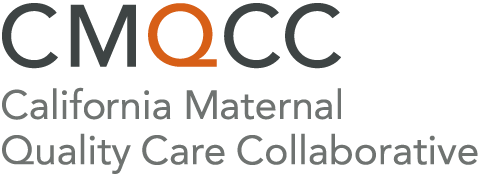About Obstetric Sepsis
Obstetric sepsis is now the second-leading cause of maternal mortality. It is also the primary cause of severe maternal morbidity during both the antepartum and postpartum periods, and the third-leading cause at delivery. Data from the California Pregnancy Associated Mortality Review (CA-PAMR) committee report estimate that 63% of maternal deaths from sepsis had a good or strong chance to have been preventable. Furthermore, for each maternal death, there are 50 women/birthing people who experience life-threatening morbidity from sepsis. This is concerning, given that prompt recognition and rapid treatment of pregnant and postpartum women/birthing people with sepsis usually results in good outcomes in this young and generally healthy population.
To assist healthcare providers in implementing evidence-based methods for timely recognition and treatment of sepsis, a community co-designed and co-led quality improvement collaborative for obstetric sepsis was launched in two states (California and Michigan). CMQCC partnered with the Dunlevie Maternal-Fetal Medicine Center at Stanford Medicine, Michigan AIM, and Duke University to increase the impact of this effort.
The Obstetric Sepsis Collaborative (Oct. 2023-Dec. 2024) engaged mentor-led groups of six to ten hospitals. Each group had four mentors including a nurse, physician, community leader, and a patient with lived experience who added a unique perspectives on this work. The Community Leadership Group and the Clinical Advisory Board, in partnership with project leadership, developed a number of resources that will advance the care of patients with obstetric sepsis. Many also address generalizable issues for all severe obstetric complications. These resources are available below.
- Advocacy Tips for Patients and Families
- Guide for Patient and Family Debriefs before Discharge
- Obstetric Sepsis Flow Chart for Screening and Diagnosis
- Urgent Maternal Warning Signs (developed by AIM/ACOG and the CDC)
- Warning Signs Follow-up Guide for Health Care Professionals
Improving Diagnosis and Treatment of Maternal Sepsis Toolkit
The Improving Diagnosis and Treatment of Maternal Sepsis Toolkit was developed by the Maternal Sepsis Task Force and published in January 2020 as a resource for obstetricians, rapid response teams, and intensive care units who interact with women/birthing people during pregnancy and in the postpartum period. The toolkit introduces a new two-step screening and confirmation process to more accurately diagnose and treat obstetric sepsis. This screening and diagnostic approach has been updated as part of the NICHD-supported Obstetric Sepsis Collaborative active in California and Michigan. As part of the review process for the collaborative, the Sepsis toolkit is undergoing revisions to update the diagnosis pages, add the Obstetric Sepsis Flow Chart for Screening and Diagnosis, and to add multiple patient-centered resources.
Download Improving Diagnosis and Treatment of Maternal Sepsis Toolkit (2020)
(Note: The Toolkit will be updated by mid-year 2025)
Beginning April 30, toolkits and related resources on our website will require a CMQCC Account login. First, locate the toolkit/resource on the website. Click on the toolkit/resource, and you will be prompted to log in or create an account. After you’ve logged in, you’ll automatically see an option to complete the download. Questions or need help? Email us at info@cmqcc.org. (Note: This is a different email than for MDC support!)
- Frequently Asked Questions (2020)
- Informational Webinar (2020)
- Slide Set for Professional Education (2020)
Individual sections of the toolkit are also available for download:
- Appendix A: Comparison of Sepsis Terminology Errata 7/1/2022
- Appendix B: CMS Sepsis-1 Accommodations for Special Populations
- Appendix C: Justification for Adjustments to CMS Sepsis-1 Criteria for End Organ Injury
- Appendix E: Collecting a Urine Specimen from a Foley Catheter
- Appendix F: The Importance of Taking a Respiratory Rate
- Appendix G: How to Take an Oral Temperature Measurement
- Appendix H: Team Reassessment Communication
- Appendix I: Sample, Maternal Sepsis Debriefing Form
- Appendix J: UC Davis Health Maternal Sepsis Drill Scenario
- Appendix K: Maternal Sepsis Sample Education Outline
- Appendix L: Lactation Safety of Antimicrobials Used for Treatment of Sepsis
- Appendix M: Sample, Sutter Health Sepsis Order Set
Key Resources
Updated September 2024
- Advocacy Tips for Patients and Families (MI-AIM/CMQCC 2024) (English)
- Advocacy Tips for Patients and Families (MI-AIM/CMQCC, 2024) (Spanish)
- Guide for Post-Discharge Care After an SME 06AUG24
- Guide for Pre-Discharge Care Discussion After an SME 06AUG24
- Important Steps for Healing After an SME 06AUG24
- Obstetric Sepsis Flow Chart for Screening and Diagnosis (CMQCC/MI-AIM 2025) (Updated 1/29/25)
- Supportive Communication After an SME 06AUG24
- Urgent Maternal Warning Signs ENGLISH (MI-AIM/ACOG, 2024)
- Urgent Maternal Warning Signs SPANISH (MI-AIM/ACOG, 2024)
- Warning Signs Follow-up Guide for Health Care Professionals (MI-AIM/CMQCC 2024)
Sepsis Collaborative Webinar Series (2023-2024):
- (Closing Webinar) Obstetric Sepsis Collaborative 2024 Webinar Series: Lessons and Progress 11/12/24
- Chorioamnionitis: Prevention, Diagnosis and Treatment 8/7/24
- Obstetric Sepsis Treatment and Patient Debriefs 5/15/24
- Maternal Sepsis: Improving our Listening Skills and Update on Screening and Diagnostic Criteria 2/6/24
- Improving Diagnosis and Treatment of Obstetric Sepsis Part 2 - Collaborative Kick Off 11/7/2023
- Improving Diagnosis and Treatment of Obstetric Sepsis Part 1 11/7/2023
Additional Webinars (2025)
Related Publications: Sepsis Quality Improvement Collaborative
- Bauer MS, et al. Performance Characteristics of Sepsis Screening Tools During Antepartum and Postpartum Admissions. Obstet Gynecol. 2024 Mar 1;143(3):336-345.
- Main EK, et al. Performance Characteristics of Sepsis Screening Tools During Delivery Admissions. Obstet Gynecol. 2024 Mar 1;143(3):326-335.
- Shields AD, Tse BC. Finding the Needle in the Haystack: Challenges and Future Directions in Maternal Sepsis Recognition. Obstet Gynecol. 2024 Mar 1;143(3):323-325.
Funding Acknowledgement
Funding for the joint California and Michigan Obstetric Sepsis QI Collaborative is provided by a cooperative agreement with NICHD (UH3-HD108053).
